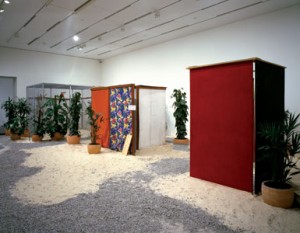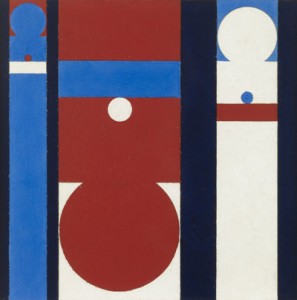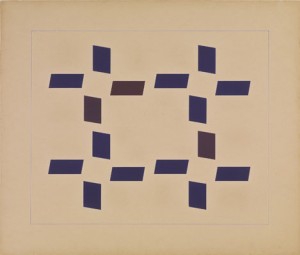Helio Oiticica at Galerie Lelong
Helio Oiticica is said to have announced that we should ignore his work from the 1950’s. He was speaking from a heady place. The late 1960’s, where his oeuvre had a retrospective contour shaped by the Bolides –boxes that were a sort of hybrid of Cornell and Fluxus– robes and coats for performances (Parangoles), and proto-installations know as Penetrables. One of the latter had given its name to the movement Tropicalismo, arguably, alongside Cinema Novo, Brazil’s most gregariously inclusive, radical, politico-cultural movement of the mid twentieth century.
Indeed there is something inherently populist –gregarious– about the Penetrables and Parangoles which required the active engagement of viewers, whether they were residents of Rio’s favellas where Oiticica worked with samba troupes as performers who wore his Parangoles or visitors to his 1969 one person show at the Whitechapel in London.
Perhaps, then, it is a good thing that Galerie Lelong –and the Grey art gallery in 2007– ignored the artists’ injunction. Oiticica’s work from that period is the subject of a small show at Lelong through February 6th. Many of the twenty plus small works are from the period when Oiticica was associated with Grupo Frente the modernist circle whose work was much influenced by the geometric abstraction of neoplasticism, and suprematism. The work while not exactly juvenilia -–though Oiticica was very, very young– seems to speak of the swirl of influences that shaped a Brazilian struggle to define is own version of modernism. Optimistically such an engagement with modernism would be not an extension of European imperialism but rather a stroke of Antropófago (pretty much literally cannibalism). Antropófago being the Brazilian poet José Oswald de Andrade’s brilliant conception of his nations’ resistance to postcolonialism via a devouring, or cannibalizing of the influencing cultures to make them authentically Brazilian. Stuff it in, gulp it down and spit it out as your own not theirs.
Whether or not the notion of cannibalism really does neutralize the emperor’s agents is a matter for some debate. The lines that connect back from Grupo Frente and Oiticica to Europe do seem pretty strong and at this distance pretty conservative, pretty much like a wish to have the apprentices’ work legitimized by the master. With that caveat in place it must be said the work holds up as what it is. In, say, Grupo Frente 24, (1955), the color range is limited and the interaction between hues quietly constrained. Yet the sharply defined shapes, often repeated, make animated spatial plays and offer promises of movement (More so than in Mondrian I might snarkily observe).
Or in Metaesquema No. 209, (1956–58) with a palette so limited it is all but monochrome, the kinetic sense of graphic animation holds the piece together against the apparent centripetal force of its whirligig icons.
Not that Oiticica’s work in any way resembles Ben Nicholson’s but I am put in mind of that sense of the provincial’s wish to import the vaunted metropolitan culture. This is not a position to disrespect. To want to make the excitement of the radical culture ones own, as Nicholson clearly did, is with Oiticica the way that cannibalism survives –or comes into being. Cannibalism of course ups the ante on Nicholson. But its shadow is present in the Lelong show because the lines forward in time to Oiticica’s Parangoles and Penetrables are also hinted at here. The encounter with color, one might even say pure color as unencumbered by context and reference as can be, is a thread that ties these small drawings to the large installations wherein the viewer’s encounter was primarily with architecturally scaled sheets or walls of color. No we cannot necessarily say of Oiticica’s work that the former presaged the latter and yes we are operating now with hindsight. But it is in attempting to draw such connecting filaments that we can recognize the importance of shows such as this one. History is context. And what’s that old saw, context is everything.








